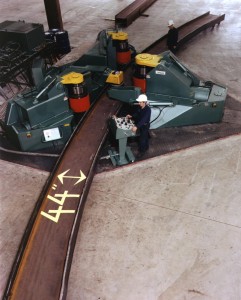A common question from those who are not familiar with the operation of a section bender (also called an angle roll, a pyramid roll, or a 3-roll bender) is how many passes (rollings back and forth) does it take to roll a wide-flange beam to the specified radius. A related question arises from those who seek to maximize productivity on these machines: Can you achieve the desired radius in one pass?
As with many aspects of curving steel, the answer is, it depends.
How many passes are required depends partly on the machinery doing the bending. Modern section benders allow precise, repeatable, settings of the tooling. Unlike older machines that might have some “play” in the shafts, the new machines are tightly constructed with multiple main and calibrating rolls for maximum control.

The number of passes required also depends on the skill of the operator. Rolling is more of an art than a science. After years of experience, skilled operators can often curve steel very close to the desired radius even in one pass. And even then, it depends on the required tolerances.
Finally, the number of passes required is often dictated by the dimensional tolerances of the section being rolled. For example, beams with a nominal depth over 12″ have a tolerance of +/- 1/8″ at the web centerline. And operators know from experience that this dimension, for example, may vary significantly even from beam to beam from the same steel mill and from the same heat. Furthermore, the physical and chemical properties of the steel beams can also vary from beam to beam, again, even from the same heat. Experience also tells us that even within a single beam, there can be dimensional as well as physical and chemical variation. And even with the best machinery and the best operators, this variation will probably increase the number of passes required to achieve close tolerance radii.
So it is common to see beams being curved with 2, 3, 4, or 5 passes depending on the factors discussed above. In almost every case, however, by using a multiple-pass procedure with the best equipment and skilled operators, excellent curving can be achieved.
[maxbutton id=”1″]







